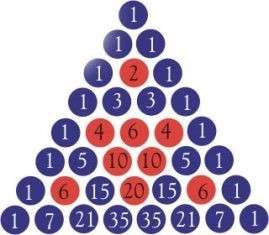Vedic Math Tricks for You

Vedic Math is based on sixteen sutras or principles. These principles are general in nature and can be applied in many ways.
By 23rd Feb, 2014 | 11:13 am
ShareVedic Math is based on sixteen sutras or principles. These principles are general in nature and can be applied in many ways. In practice many applications of the sutras may be learned and combined to solve actual problems.

Following are some examples of how Vedic Math tricks enhance your problem solving skills.
Vedic Math Tricks
1. Is it divisible by four?
This little math trick will show you whether a number is divisible by four or not. So, this is how it works.
Let's look at 1234. Does 4 divide evenly into 1234? For 4 to divide into any number we have to make sure that the last number is even if it is an odd number, there is no way it will go in evenly. So, for example, 4 will not go evenly into 1233 or 1235. Now we know that for 4 to divide evenly into any number the number has to end with an even number.Back to the question...
4 into 1234, the solution:
Take the last number and add it to 2 times the second last number. If 4 goes evenly into this number then you know that 4 will go evenly into the whole number.
So 4 + (2 X 3) = 10
4 goes into 10 two times with a remainder of 2 so it does not go in evenly. Therefore 4 into 1234 does not go in completely. Let's try 4 into 3436546. So, from our example, take the last number, 6 and add it to two times the penultimate number, 46 + (2 X 4) = 14. 4 goes into 14 three times with two remainder.
So it doesn't go in evenly. Let's try one more.
4 into 212334436
6 + (2 X 3) = 12
4 goes into 12 three times with 0 remainder. Therefore 4 goes into 234436 evenly.
6 + (2 X 3) = 12
4 goes into 12 three times with 0 remainder. Therefore 4 goes into 234436 evenly.
2. Multiplying by 12 - shortcut
So how does the 12's shortcut work?
Let's take a look.
12 X 7
The first thing is to always multiply the 1 of the twelve by the number we are multiplying by, in this case 7. So 1 X 7 = 7. Multiply this 7 by 10 giving 70. (Why? We are working with BASES here. Bases are the fundamentals to easy calculations for all multiplication tables.
Now multiply the 7 by the 2 of twelve giving 14. Add this to 70 giving 84. Therefore 7 X 12 = 84
Now multiply the 7 by the 2 of twelve giving 14. Add this to 70 giving 84. Therefore 7 X 12 = 84
Let's try another:
17 X 12
17 X 12
Remember, multiply the 17 by the 1 in 12 and multiply by 10 (Just add a zero to the end)
1 X 17 = 17, multiplied by 10 giving 170.
Multiply 17 by 2 giving 34.
Add 34 to 170 giving 204.
So 17 X 12 = 204
Multiply 17 by 2 giving 34.
Add 34 to 170 giving 204.
So 17 X 12 = 204
Lets go one more:
24 X 12
Multiply 24 X 1 = 24. Multiply by 10 giving 240.
Multiply 24 by 2 = 48. Add to 240 giving us 288
24 X 12 = 288 (these are Seriously Simple Sums to do aren't they?!)
3. Converting Kilos to Pounds
In this section you will learn how to convert Kilos to Pounds, and Vice Versa. Let's start off with looking at converting Kilos to pounds.
24 X 12
Multiply 24 X 1 = 24. Multiply by 10 giving 240.
Multiply 24 by 2 = 48. Add to 240 giving us 288
24 X 12 = 288 (these are Seriously Simple Sums to do aren't they?!)
3. Converting Kilos to Pounds
In this section you will learn how to convert Kilos to Pounds, and Vice Versa. Let's start off with looking at converting Kilos to pounds.
86 kilos into pounds:
Step one, multiply the kilos by TWO. To do this, just double the kilos.
86 x 2 = 172
86 x 2 = 172
Step two, divide the answer by ten. To do this, just put a decimal point one place in from the right.
172 / 10 = 17.2
172 / 10 = 17.2
Step three, add step two's answer to step one's answer.
172 + 17.2 = 189.2
86 Kilos = 189.2 pounds
Let's try:
50 Kilos to pounds:
172 + 17.2 = 189.2
86 Kilos = 189.2 pounds
Let's try:
50 Kilos to pounds:
Step one, multiply the kilos by TWO. To do this, just double the kilos.
50 x 2 = 100
50 x 2 = 100
Step two, divide the answer by ten. To do this, just put a decimal point one place in from the right.
100/10 = 10
100/10 = 10
Step three, add step two's answer to step one's answer.
100 + 10 = 110
50 Kilos = 110 pounds
4. Adding Time
Here is a nice simple way to add hours and minutes together: Let's add 1 hr and 35 minutes and 3 hr 55 minutes together.
What you do is this: make the 1 hr 35 minutes into one number, which will give us 135 and do the same for the other number, 3 hours 55 minutes, giving us 355. Now you want to add these two numbers together:
135
355
___
490
100 + 10 = 110
50 Kilos = 110 pounds
4. Adding Time
Here is a nice simple way to add hours and minutes together: Let's add 1 hr and 35 minutes and 3 hr 55 minutes together.
What you do is this: make the 1 hr 35 minutes into one number, which will give us 135 and do the same for the other number, 3 hours 55 minutes, giving us 355. Now you want to add these two numbers together:
135
355
___
490
So we now have a sub total of 490. What you need to do to this and all sub totals is add the time constant of 40.No matter what the hours and minutes are, just add the 40 time constant to the sub total.
490 + 40 = 530
490 + 40 = 530
So we can now see our answer is 5 hrs and 30 minutes!
5. Temperature Conversions
This is a shortcut to convert Fahrenheit to Celsius and vice versa. The answer you will get will not be an exact one, but it will give you an idea of the temperature you are looking at.
5. Temperature Conversions
This is a shortcut to convert Fahrenheit to Celsius and vice versa. The answer you will get will not be an exact one, but it will give you an idea of the temperature you are looking at.
Fahrenheit to Celsius:
Take 30 away from the Fahrenheit, and then divide the answer by two. This is your answer in Celsius.
Example:
74 Fahrenheit - 30 = 44. Then divide by two, 22 Celsius.
So 74 Fahrenheit = 22 Celsius.
Celsius to Fahrenheit just do the reverse:
Double it, and then add 30.
30 Celsius double it, is 60, then add 30 is 90
30 Celsius = 90 Fahrenheit
Remember, the answer is not exact but it gives you a rough idea.
6. Decimals Equivalents of Fractions
With a little practice, it's not hard to recall
the decimal equivalents of fractions up to 10/11!
First, there are 3 you should know already:
1/2 = .5
1/3 = .333...
1/4 = .25
Starting with the thirds, of which you already know one:
1/3 = .333...
2/3 = .666...
You also know 2 of the 4ths, as well, so there's only one new one to learn:
1/4 = .25
2/4 = 1/2 = .5
3/4 = .75
Fifths are very easy. Take the numerator (the number on top),
double it, and stick a decimal in front of it.
1/5 = .2
2/5 = .4
3/5 = .6
4/5 = .8
There are only two new decimal equivalents to learn with the 6ths:
1/6 = .1666...
2/6 = 1/3 = .333...
3/6 = 1/2 = .5
4/6 = 2/3 = .666...
5/6 = .8333...
What about 7ths? We'll come back to them at the end. They're very unique. 8ths aren't that hard to learn, as they're just smaller steps than 4ths. If you have trouble with any of the 8ths, find the nearest 4th,and add .125 if needed:
1/8 = .125
2/8 = 1/4 = .25
3/8 = .375
4/8 = 1/2 = .5
5/8 = .625
6/8 = 3/4 = .75
7/8 = .875
1/8 = .125
2/8 = 1/4 = .25
3/8 = .375
4/8 = 1/2 = .5
5/8 = .625
6/8 = 3/4 = .75
7/8 = .875
9ths are almost too easy:
1/9 = .111...
2/9 = .222...
3/9 = .333...
4/9 = .444...
5/9 = .555...
6/9 = .666...
7/9 = .777...
8/9 = .888...
10ths are very easy, as well.
Just put a decimal in front of the numerator:
1/10 = .1
2/10 = .2
3/10 = .3
4/10 = .4
5/10 = .5
6/10 = .6
7/10 = .7
8/10 = .8
9/10 = .9
Remember how easy 9ths were? 11th are easy in a similar way,
assuming you know your multiples of 9:
1/11 = .090909...
2/11 = .181818...
3/11 = .272727...
4/11 = .363636...
5/11 = .454545...
6/11 = .545454...
7/11 = .636363...
8/11 = .727272...
9/11 = .818181...
10/11 = .909090...
As long as you can remember the pattern for each fraction, it is quite simple to work out the decimal place as far as you want
or need to go! Oh, I almost forgot! We haven't done 7ths yet, have we? One-seventh is an interesting number:
1/7 = .142857142857142857...
For now, just think of one-seventh as: .142857
See if you notice any pattern in the 7ths:
1/7 = .142857...
2/7 = .285714...
3/7 = .428571...
4/7 = .571428...
5/7 = .714285...
6/7 = .857142...
See if you notice any pattern in the 7ths:
1/7 = .142857...
2/7 = .285714...
3/7 = .428571...
4/7 = .571428...
5/7 = .714285...
6/7 = .857142...
Notice that the 6 digits in the 7ths ALWAYS stay in the same order and the starting digit is the only thing that changes! If you know your multiples of 14 up to 6, it isn't difficult to,work out where to begin the decimal number. Look at this:
For 1/7, think "1 * 14", giving us .14 as the starting point.
For 2/7, think "2 * 14", giving us .28 as the starting point.
For 3/7, think "3 * 14", giving us .42 as the starting point.
For 4/14, 5/14 and 6/14, you'll have to adjust upward by 1:
For 4/7, think "(4 * 14) + 1", giving us .57 as the starting point.
For 5/7, think "(5 * 14) + 1", giving us .71 as the starting point.
For 6/7, think "(6 * 14) + 1", giving us .85 as the starting point.
For 2/7, think "2 * 14", giving us .28 as the starting point.
For 3/7, think "3 * 14", giving us .42 as the starting point.
For 4/14, 5/14 and 6/14, you'll have to adjust upward by 1:
For 4/7, think "(4 * 14) + 1", giving us .57 as the starting point.
For 5/7, think "(5 * 14) + 1", giving us .71 as the starting point.
For 6/7, think "(6 * 14) + 1", giving us .85 as the starting point.
Practice these, and you'll have the decimal equivalents of everything from 1/2 to 10/11 at your finger tips! If you want to demonstrate this skill to other people, and you know your multiplication tables up to the hundreds for each number 1-9, then give them a calculator and ask for a 2-digit number (3-digit number, if you're up to it!) to be divided by a 1-digit number. If they give you 96 divided by 7, for example, you can think, "Hmm... the closest multiple of 7 is 91, which is 13 * 7, with 5 left over. So the answer is 13 and 5/7, or: 13.7142857!"
7. Converting Kilometres to Miles
This is a useful method for when travelling between imperial and metric countries and need to know what kilometres to miles are.
The formula to convert kilometres to miles is number of (kilometres / 8 ) X 5. So lets try 80 kilometres into miles 80/8 = 10 multiplied by 5 is 50 miles!
Another example
40 kilometres
40 / 8 = 5
5 X 5= 25 miles
Tags:
Vedic Math Tricks
More from Education
Important Resources
- Education Franchisee opportunity
- NCERT Solution
- CBSE Class 9 Mathematics
- NCERT Solutions for class 10 Science
- Sample Papers
- CBSE Class 9 Science
- NCERT Solutions for class 10 Maths
- Revision Notes
- CBSE Class 10 Hindi
- CBSE Class 10 English
- CBSE Class 10 English
- CBSE Class 10 Social Studies
- CBSE Class 10 Science
- CBSE Class 10 Mathematics
- Career In Science After 10
- Career In Commerce After 10
- Career In Humanities/Arts After 10
- NCERT Solutions for Class 10
- NCERT Solutions for Class 11
- Business Studies Class 12 CBSE project





